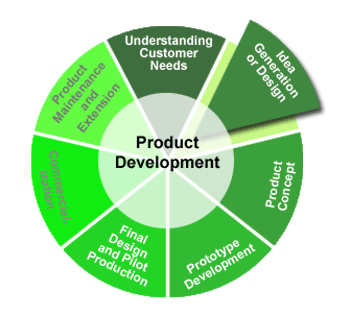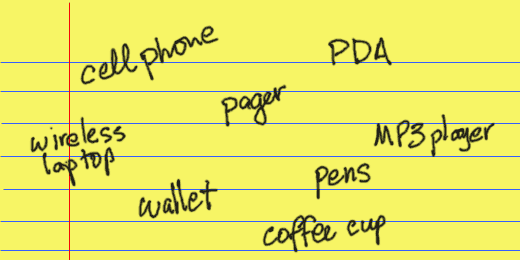Product Development Stages
 Idea Generation or Design Idea Generation or Design
Designers' work is the generation of ideas. But contrary to many people's beliefs, ideas are not usually "flashes of brilliance" or intuitive creativity. Design is hard work. It requires researching ideas and trends, educated guesses, and trying out alternatives. Inspirations from art, architecture, nature, or the streets can help you generate multiple ideas. Then you can try out some of the ideas and decide which ones are best.
The design process includes
- analyzing customer needs
- defining the design problem
- ideating or generating ideas
- selecting design criteria
- implementing one or several prototypes
- evaluating prototypes against design criteria.

Design Development Example: Initial sketch, 2nd sketch, final sketch and final design illustration
Individual designers use all of these steps, but often develop an order that works best for them. A variety of methods can be used to generate design ideas.
Brainstorming is one of the simplest and most effective methods of generating ideas. You can start with your initial idea - say, that people have many electronic gadgets that they need a way to carry. Then, write down all of the possible ways that these gadgets could be carried. For example,
- in a pocket
- in a bag
- on the shoulder
- on the wrist on the belt
- and on and on
Once you have a long list of options, you can start designing clothing and accessories based on these possible carrying strategies. Brainstorming helps you to get lots of ideas and to consider each one's merits.
A similar strategy is the mind map. Starting with the same need (carrying gadgets), you divide the problem into different concepts. You could start by listing all of the gadgets that need to be carried, such as cell phone, PDA, wireless laptop, pager, etc. You can add some low-tech things that also need to be carried, such as wallets, credit cards, and pens. Write all of these on a piece of paper in different locations.

Now, next to each item, you list all of the possible design solutions for carrying it, including body placement, apparel, or accessory. Once you have a number of solutions for each item, you can see whether several items can be carried using one design solution.
For this example, the mind map can be started with body parts instead of gadgets. You can list all of the body parts that might be involved in carrying electronic gadgets, for example, the wrist, waist, upper arm, head, thigh, and chest. Then, for each location, list the types of solutions that would work at that location. At the wrist, a band or pocket purse might hold a PDA so that it can be used while attached. At the waist, a cell phone, PDA, pager, or wallet could be attached to the belt, attached as a fanny pack, built into pants as extended pockets, etc.
The objective is the same as brainstorming - to generate numerous ideas that you can evaluate and perfect. One or several of these many ideas may lead to an innovative design that customers will value and buy.
A group ideation session can be especially successful at generating ideas that are innovative and "outside the box." Getting a group of people together to brainstorm or develop mind maps generates creative energy and "way out" ideas. "Way out" ideas sometimes identify a surprise kernel that sends you on the road to an innovative product design. In all ideation sessions, it is important to write down every idea, no matter how wacky. Then, go back and discuss the merits of each idea, discussing how the design might look, how well it would carry, and so on. The best ideas can be developed further during group discussion.
Experimentation with materials, finishes, stitching, or draping can also be used to generate design ideas. For example,
- draping fabric on dress forms to create unique design variations
- folding and stitching material to create texture, and
- painting or printing fabric inspired by color, nature, or street art.
 |

 "I like to take a plain fabric...like muslin and see what it will do when you stitch it this way and wash it and shrink it. That's the fun part...I want to manipulate it. " "I like to take a plain fabric...like muslin and see what it will do when you stitch it this way and wash it and shrink it. That's the fun part...I want to manipulate it. "
Carol Young describes how she manipulates and changes fabrics during her design process.
|
|

1. Identify a problem and at least 5 apparel or sewn product solutions using brainstorming, mind maps, or ideation.
2. Using a product idea you have and one of these creative methods, identify 3 alternative design solutions to your problem.
|
|



